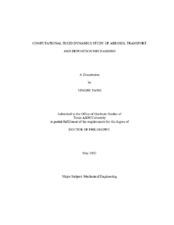| dc.description.abstract | In this work, various aerosol particle transport and deposition mechanisms were studied through the computational fluid dynamics (CFD) modeling, including inertial impaction, gravitational effect, lift force, interception, and turbophoresis, within different practical applications including aerosol sampling inlet, filtration system and turbulent pipe flows. The objective of the research is to obtain a better understanding of the mechanisms that affect aerosol particle transport and deposition, and to determine the feasibility and accuracy of using commercial CFD tools in predicting performance of aerosol sampling devices. Flow field simulation was carried out first, and then followed by Lagrangian particle tracking to obtain the aerosol transport and deposition information. The CFD-based results were validated with experimental data and empirical correlations.
In the simulation of the aerosol inlet, CFD-based penetration was in excellent agreement with experimental results, and the most significant regional particle deposition occurred due to inertial separation. At higher free wind speeds gravity had less effect on particle deposition. An empirical equation for efficiency prediction was developed considering inertial and gravitational effects, which will be useful for directing design of similar aerosol inlets.
In the simulation of aerosol deposition on a screen, a "virtual surface" approach, which eliminates the need for the often-ambiguous user defined functions, was developed to account for particle deposition due to interception. The CFD-based results had a good agreement compared with experimental results, and also with published empirical correlations for interception.
In the simulation of turbulent deposition in pipe flows, the relation between particle deposition velocity and wall-normal turbulent velocity fluctuation was quantitative determined for the first time, which could be used to quantify turbulent deposition, without having to carry out Lagrangian particle tracking. It suggested that the Reynolds stress model and large eddy simulation would lead to the most accurate simulated aerosol deposition velocity. The prerequisites were that the wall-adjacent y+ value was sufficiently low, and that sufficient number of prism layers was applied in the near-wall region. The "velocity fluctuation convergence" would be useful criterion for judging the adequacy of a CFD simulation for turbulent deposition. | en |


